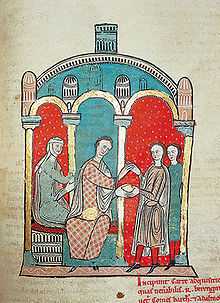Almodis de la Marche
| Almodis de la Marche | |
|---|---|
 Ramon Berenguer I and his wife, Almodis de la Marche, counting out 2,000 ounces of gold coins as payment to William Raymond and Adelaide, count and countess of Cerdagne, in return for their rights over Carcassonne in 1067.[1] | |
| Spouse(s) |
Hugh V of Lusignan Pons of Toulouse Ramon Berenguer I, Count of Barcelona |
| Noble family | House of Marche |
| Father | Bernard I, Count of Marche |
| Mother | Amélie |
| Died | 1071 |
Almodis de la Marche (c. 1020 – 16 October 1071) was the daughter of Bernard I, Count of Marche and wife Amélie. She married Hugh V of Lusignan around 1038 and they had two sons and one daughter:
- Hugh VI of Lusignan (c. 1039–1101)
- Jordan de Lusignan
- Mélisende de Lusignan (b. bef. 1055), married before 1074 to Simon I "l'Archevêque", Vidame de Parthenay
Almodis and Hugh of Lusignan divorced due to consanguinity, and Hugh arranged for her to marry Count Pons of Toulouse in 1040. Together they produced several children, including:
- William IV of Toulouse
- Raymond IV of Toulouse
- Hugh, Abbot of Saint-Gilles
- Almodis of Toulouse, married Count Pierre of Melgueil
She was still Pons' wife in April 1053, but shortly thereafter Almodis was abducted by Ramon Berenguer I, Count of Barcelona. He kidnapped her from Narbonne with the aid of a fleet sent north by his ally, the Muslim emir of Tortosa. They married immediately (despite the fact both of her previous husbands were still alive) and they appear with their twin sons in a charter the next year. Pope Victor II excommunicated Almodis and Ramon for this illegal marriage until 1056. Together they produced four children:
- Berenguer Ramon II, Count of Barcelona
- Ramon Berenguer II, Count of Barcelona
- Agnes of Barcelona, married Count Guigues II of Albon
- Sancha of Barcelona, married Count Guillermo Ramon I of Cerdagne
Almodis maintained contact with her former husbands and many children, and in 1066/1067 she traveled to Toulouse for her daughter's wedding. A few years before, in 1060, Hugh V of Lusignan had revolted against his lord, Duke William VIII of Aquitaine, in support of Almodis' son William IV of Toulouse. Her sons supported one another in military campaigns; Hugh VI of Lusignan, Raymond IV of Toulouse, and Berenguer Ramon all took the Cross.
Her third husband Ramon was married to her sister Rangearde de la Marche's daughter Isabela Trencavel originally,their son Pere-Ramon was his heir. Pere apparently resented Almodis' influence and was concerned she was trying to replace him with her own two sons, his consanguinous nephews, who had both his late mother's and his step-mother's claims through their Father, Count La Marche. He murdered her in October 1071. Pere was disinherited and exiled for his crime, and fled the country. When his father died in 1076, Barcelona was split between Berenguer Ramon and Ramon Berenguer, Almodis' sons. The family history of murder did not end with Pedro Ramon, as Berenguer Ramon earned his nickname "The Fratricide" when he killed his own twin brother.
Sources
- Chronicles of the abbey of St. Maixent (pub. 1886 by A. Richard)
- Reilly, B. F. The Conquest of Christian and Muslim Spain, 1992
Notes
- ↑ Charles Julian Bishko (1968–9), "Fernando I and the Origins of the Leonese-Castilian Alliance with Cluny," Studies in Medieval Spanish Frontier History (Variorum Reprints), 40.